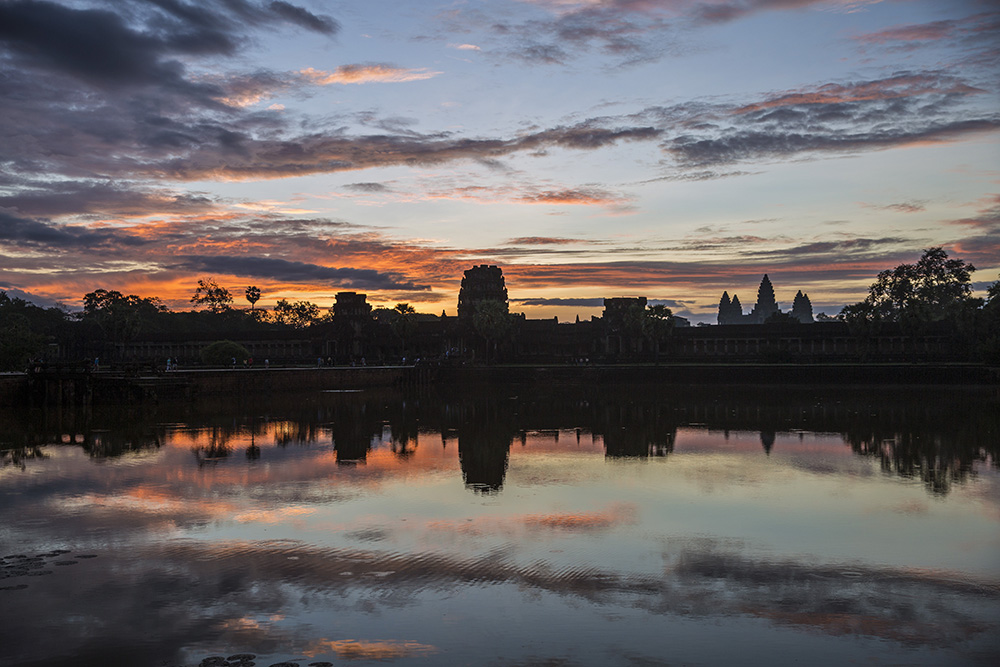Cambodia is a dream destination for many adventurous world travellers because of its sightseeing (including the awe-inspiring temples of Angkor Wat), and its rich culture, art, markets, and food.
But Cambodia is also a land of stark contrasts, with an at-times tragic history. There is a way to experience Cambodia that honours and remembers the past — while giving the visitor an immersion into what makes this place so special.

The temples of Angkor Wat.
The Magic of Angkor Wat
This sprawling 12th-century temple complex outside Siem Reap is the main draw for most people who visit Cambodia. Exploring the fascinating ruins with a knowledgeable, local tour guide who understands the mythology, history, and archaeology of Angkor can make the difference between a memorable experience and a life-changing one.
My guide, a survivor of the Khmer Rouge, was able to share not only details of the temple city, but also of Cambodian history itself, including how these intertwined, and the legacy still felt today from the ancient empire. Her name was Ponheary Ly, and she was in no hurry to shuttle us from spot to spot; she allowed us to soak up the temples instead of rushing through. Her own personal love of the place was apparent as she spoke: she recalled how she came to Angkor Wat as a child to play, and it was clear that she had never grown tired of it.
As I spent time with her, I noticed that it was very difficult for Ponheary to look at any depictions of suffering or violence within the temple; she averted her face from the carved visions of agony on the walls. “It is too hard to see,” Ponheary, who had witnessed far too much killing in her lifetime, explained.
When we came upon some of the many child beggars who crowd the temple exits, Ponheary — a former teacher — revealed that she had been using some of her earnings from working as a tour guide to help send some of these children to school with her Ponheary Ly Foundation. It’s hard for a tourist to escape Cambodia’s poverty, but supporting some local initiatives can clearly have a positive impact on both visitor and resident.
Supporting sustainable tourism
Ponheary’s foundation facilitates “Help for a Day” opportunities, which sponsor school field trips to Angkor Wat. Many children who have a daily view of the temples have never been able to step inside, and are unaware of their own heritage and culture. People can also provide and distribute backpacks to local schoolchildren, or cook lunch for them.
At the Life and Hope Association in Siem Reap, the monks of Wat Damnak are committed to breaking the cycle of poverty for women and children by providing five educational and work-assistance projects. They invite visitors to bring donations of food, school kits, or supplies for their sewing school. Tourists can also purchase beautifully made products from the sewing centre graduates.

A worker at Planeterra's New Hope Cambodia initiative.
G Adventures travellers also give back to the people of Cambodia by visiting the Planeterra Foundation’s New Hope Outreach Centre. Learn more about that project by clicking here.
The Cambodian Land Mine Museum & School
Aki Ra was a child soldier who can’t recall what year he was born in, but his memories of being forced to lay land mines for the Khmer Rouge — and later the Vietnamese army — are all too clear. In the early 1990s, Aki Ra took it upon himself to begin clearing these mines, which had killed and disfigured thousands of innocent Cambodians. Since then, he and his team have cleared an estimated 50,000 unexploded mines and weapons. Aki has since founded a non-profit organization and museum staffed by former soldiers and war crime victims.
Aki Ra’s museum educates visitors on the importance of clearing landmines in Cambodia. With potentially 5,000,000 still in the ground, landmines have immensely impacted the history and culture of the country. The museum features an impressive collection of thousands of landmines, informative exhibits, and has an associated school and relief centre that supports at-risk Khmer children.
Wat Thmei Temple
This small monastery complex serves as a sober memorial to the victims of genocide in Cambodia’s Killing Fields. Wat Thmei was one of the sites of these atrocities, and on the site, monks have built a glass stupa that is filled with the skulls and bones of those who died at the hands of the Khmer Rouge.
It’s not for everyone, and it’s admittedly a difficult thing to see. The monastery is also home to an orphanage and school, and the sound of children’s laughter in the background serves as a reminder that life continues — and provides a sense of hope. Taking a moment to pay homage to this dark chapter of history is an act that the monks hope will ensure such a thing never occurs again in their country.
These are often difficult things to see and think about. But it’s important for visitors to acknowledge that they happened, so that they might never take place again.
Getting there
Want to learn more about Cambodia firsthand? G Adventures can get you there. Check out our small group tours to Cambodia here.























